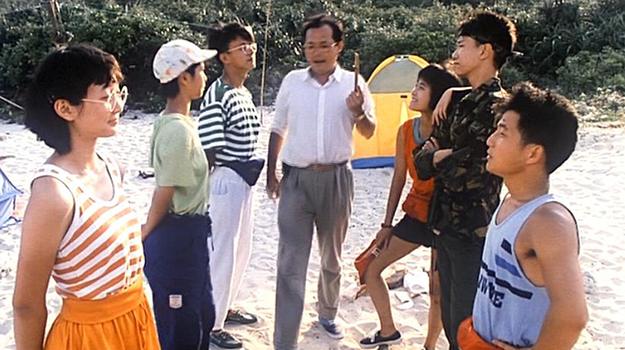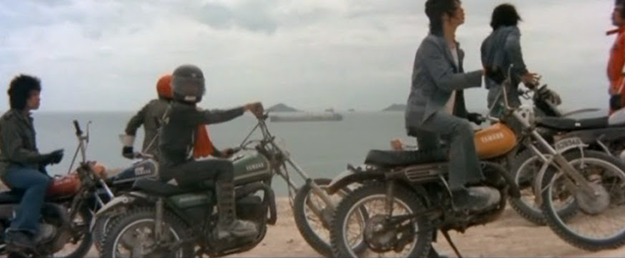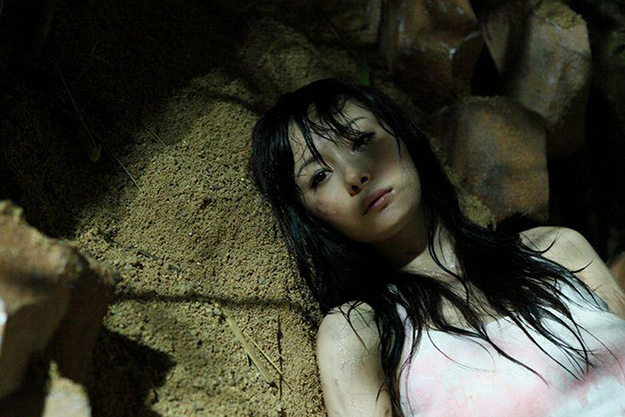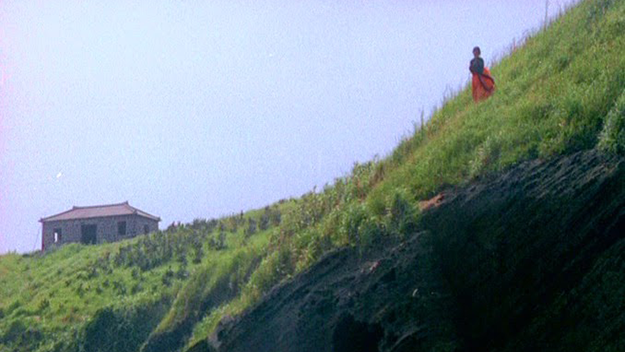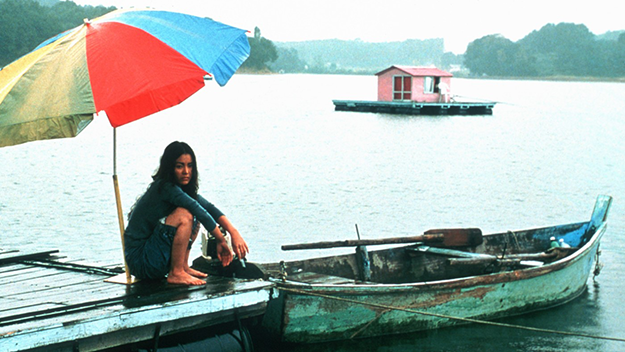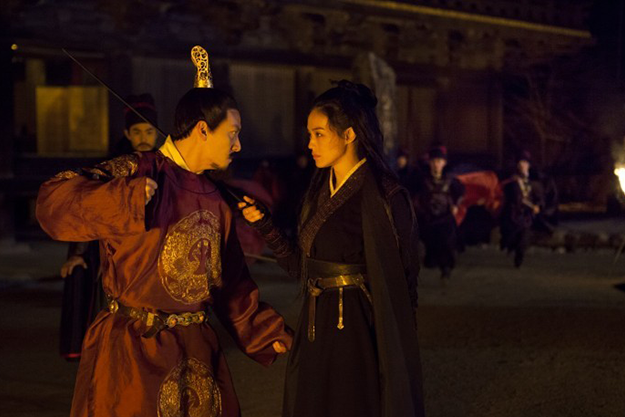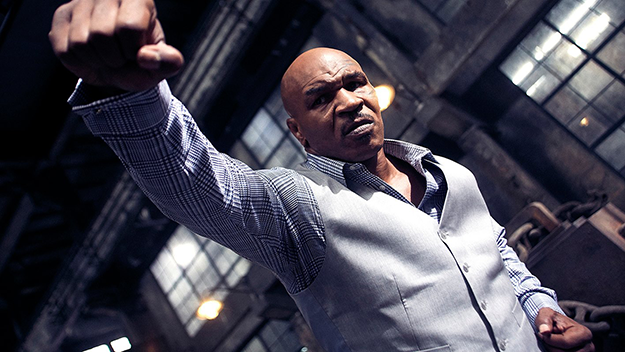The Island As the weather gets warm your thoughts naturally turn to… an island vacation! After watching hundreds of Asian movies, I have one word of advice: don’t. According to these movies, the only reason to go on an island getaway is to be murdered by rednecks, eaten by zombies, or drained of blood by vampires. From Thailand to Korea, from Japan to China, there’s one thing Asian movies agree on: islands suck. Hong Kong’s The Island (85) sets the tone. Directed by Po Chih-leong (He Lives By Night, Jumping Ash), it’s the sad yet ultraviolent story of a geography teacher (played by democracy activist John Shum) who takes his seven students camping on Tung Ping Chau, one of Hong Kong’s many outlying islands. Its only inhabitants are the three Fat brothers who run the island’s sole store. There’s horny Yee Fat, powerful Dai Fat, and mentally challenged Sam Fat, who must carry on the family line despite having an IQ lower than his shoe size. The brothers have already abducted an illegal immigrant to become Sam Fat’s wife, but after their domineering mom croaks while manually checking the bride-to-be’s hymen (discovering she’s not a virgin and therefore not a suitable match for her boys), they need a back-up plan. Fortunately, one of John Shum’s students is Phyllis, who makes the mistake of being nice to Sam Fat. Brother Dai Fat negotiates her marriage with Shum, who plays along to be polite, but when the Fat brothers discover Phyllis isn’t actually going to marry into their family, they go berserk. The whole movie is a parody of China’s “Up to the Mountains, Down to the Countryside Movement,” a misguided policy that sent urban students to live and work in rural areas where they were supposed to learn from the people there. Throughout The Island the students discuss what they can learn from these “grassroots” people, but ultimately all they learn is how to die—whipped with killer cobras, impaled on gigs, and spiked by sea urchins.
Killers on Wheels Think of how few American movies are set in Hawaii or the Florida Keys. Then look at movies like Hong Kong’s Killers on Wheels (76), a riff on Straw Dogs only with more motorcycles wherein bike gangs murder vacationing city folk on one of Hong Kong’s outlying islands. Or take A Day Without Policemen (93) in which Simon Yam’s police officer gets sent to the outlying islands after he’s left shell-shocked and impotent by criminals with AK-47s who gun down his buddies. Or Tsui Hark’s We’re Going to Eat You (80) which is basically The Texas Chain Saw Massacre only with an entire village of cannibalistic inbreeds living on the islands — and more kung fu. Hong Kong is a dense urban environment, so its outlying islands become its Texas: a rural landscape where there’s no escape and no one can hear you scream. But there’s more going on here than just geography. Hong Kong’s islands are a place where the supernatural is close to the surface, whether it’s Roy Cheung’s horny amphibian in Escape from Coral Cove (86), or the squad of ghosts out for revenge against a Chinese opera company in Ann Hui’s The Spooky Bunch (80). In part, that’s because its islands are full of isolated, rural communities which still observe older Taoist traditions like Cheung Chau’s Bun Festival and are studded with remote temples like Tin Hau on Lamma and Pak Tai Temple built in 1783. They’ve also become associated with death, at least in the last few decades. Back in 1989, at the Bela Vista Villa, a rental resort on Cheung Chau island, a mother killed her son and hung herself. Between 1999 and 2000, at the same resort, 13 more people committed suicide, mostly by inhaling carbon monoxide from charcoal heaters, leading a local legislator to call for a Suicide Theme Park to be built (Disney World was built on nearby Lantau Island instead). The incidents were immortalized in Billy Tang’s Dial D for Demons (00) a teen horror movie based on the incidents.
Mysterious Island The island as a place of death and dying bleeds over into Mainland China, which released Mysterious Island (11), about a reality show where the contestants are hunted down and killed on a remote island for sport (it spawned Mysterious Island 2 (13) which doesn’t much take place on an island). Japan has its own death island preserved on film in Kinji Fukasaku’s survival horror flick, Battle Royale (00), where kids are sent to an island to murder each other for the entertainment of adults. And Japan’s wildly popular manga, Higanjima, about a gang of vampire mutants living on an isolated island who murder interlopers, spawned a feature film, Higanjima (10), a video game, and a TV show. So islands are violent, unsettled, isolated places where death is ever-present. Then there’s Thailand’s Dead Bite (11) about a hip hop crew that goes to a remote island to film their latest video. They run up against sharks, underwater zombies and, more to the point, a primitive tribe ruled by a living goddess who instructs her followers to kill for her. And that brings us to the island as a place where women rule. Like Wonder Woman’s Paradise Island, in Asian movies islands are where the ladies are. You can see it in Shunji Iwai’s All About Lily Chou Chou (01) which features a mid-movie trip to Okinawa where our tortured high school students not only witness their first death (a cyclist struck by a car) but almost drown themselves. Okinawa is depicted as an island paradise dominated by athletic amazons in biking shorts. If the islands are where primitivism thrives, it’s a primitivism ruled by women.
Iodo Island Kim Ki-Young’s Iodo Island (77) takes this literally. Running almost two hours, the plot is difficult to describe, but it begins when a PR man unveils a new island resort, Iodo, named after a legendary island of women where fishermen go when they drown. A local resident attacks him for exploiting traditional beliefs, then goes missing. Presumed dead, the PR guy is accused of his murder. Mr. PR Man winds up on nearby Parang Island, which all the men have abandoned (“Men don’t last for long on this island,” one woman observes) leaving it to be inhabited solely by women. Flashbacks disgorge flashbacks until we’re enmeshed in a complicated backstory revolving around procreation, deals with the devil, and more procreation. A female shaman rules the island, there are abalone-breeding schemes, pig-breeding schemes, and the greatest entrance line for a femme fatale in Korean cinema history (“My sow is in heat. I need one of your boars,” she purrs). It’s genuinely shocking, even today: if you don’t gasp at the shamanistic ritual featuring a big wooden dildo, you’ll probably be fine when a corpse is retrieved from the sea and a pipe is inserted into its penis so a woman can be impregnated by its “cold semen.” Shot on one of the most inhospitable islands ever put on film—all rocky shores and cold, crashing waves—it’s a movie that’s in awe of, “the incredible energy women devote to giving birth to the next generation,” as Kim Ki-Young puts it. Nine years previously, Shohei Imamura mined similar territory in his epic, Profound Desire of the Gods (68) a movie that took over a year to shoot because, reportedly, Imamura fell in love with its island location. Set on Kurage Island, where life is primitive, harsh, and cut off from the modern world, it tracks the island’s inhabitants, their fertility rituals, their sex lives, and their deep suspicion of outsiders. It’s an earthy movie that shoots its island inhabitants the same way it films its tropical lizards: dispassionately, but wholly fascinated with their mating habits. Just as Kim Ki-Young reduced humanity to an unstoppable urge to produce more life no matter what the circumstances, Imamura is fascinated by the powerful, spurting, violent life force of the island as it’s embodied by its human (and animal) inhabitants.
The Isle Hong Kong acknowledges the female focus of island movies with its trend of island-based romances like Just One Look (02) and Sealed With A Kiss (99) that leaven their sentimentality with spasms of violence, strong female characters, and ever-present death looming over everything. And Korea reverses the polarity with Bedeviled (10) about an island where men keep the women as virtual slaves, a matter only resolved with some last reel female consciousness-raising involving scythes and decapitation. But the trend of movies where islands serve as a nexus of violence, nature, primitive ritual, and femininity reaches its dizzying heights in Kim Ki-Duk’s The Isle (00). A cop on the run holes up on a remote fishing lake, renting a floating cabin from a woman who refuses to speak. It’s only after intense violence is done to men, fish, and women alike, and nature is embraced in all its filthiness (including a close-up of a pooping butt) that we learn where exactly this Isle is located. Inside the lead character’s vagina. Literally. And that pretty much says it all right there.
LINKS! LINKS! LINKS!
The Assassin … The Asian Film Awards are Hong Kong’s admirably ambitious attempt to create a film award that reaches across all the Asian film industries, from the Philippines to Bollywood and beyond. In past years they’ve given special awards to David Bordwell, Amitabh Bachchan, Priyanka Chopra, Eugene Domingo, Eddie Garcia, and a host of folks who aren’t from China, Japan, or Korea. But more often than not, it’s a film from one of the Big Three that takes the major awards, and this year was no exception with Hou Hsiao-hsien’s The Assassin sweeping eight awards for
- Best Film * Best Director * Best Actress * Best Supporting Actress * Best Cinematography * Best Production Design * Best Original Music * Best Sound The only winner of the evening who wasn’t from one of the Big Three (and, yes, I’m lumping in Hong Kong and Taiwan with China) was Prasad Sutar who won Best Visual Effects for the Indian film Bajirao Mastani. Given that there were only two winners not from the Big Three last year, and only two the year before, things don’t look great for folks from India, the Philippines, Iran, Thailand, Indonesia, or even Singapore at the AFAs. You have to go back to 2013, which had two Filipino winners, three Iranian winners, and two Indian winners, to find a year that embodied the awards’ intended broader reach. … The Busan Film Festival is mired in controversy yet again. While the festival’s budget has been restored by the government and the city of Busan, filmmakers and many major film industry organizations in Korea are now calling for the mayor of Busan to step down as chairman of the festival, and for government officials to ensure the fest’s autonomy. The city objected to festival advisors being appointed without what they felt was proper consultation (the festival maintains that advisors have never before required the festival chairman’s approval). That action resulted in a lawsuit filed by the city against the festival, and sparked an “emergency committee,” made up of members of nine industry organizations, to announce that they will boycott the festival in October if their concerns are not addressed. In addition, at last year’s Cannes festival, 114 people in the film festival community signed an open letter to the mayor asking for him to stop “pressuring” the festival. Tony Rayns, one of the festival’s foreign advisors, has written at length on his feelings about the matter. … Speaking of Cannes, last year John Woo gave an interview there about his next movie, Manhunt, a remake of the 1976 Japanese thriller Kimi yo Fundo no Kawa o Watare (aka Manhunt) which starred Takakura Ken. Released in China, the 1976 film became a huge hit and stuck in Woo’s consciousness forever. Looking for a way to honor Takakura Ken after his death, Woo hit on the idea of remaking Manhunt. It’s been a long road to get the film off the ground, owing perhaps to the box office failure of Woo’s two-part epic, The Crossing. But now, casting has been announced and it looks like Masaharu Fukuyama will join Stephy Qi Wei and Zhang Hanyu. With a budget of $30 million, it’s being produced by Media Asia and is set to film mostly in Osaka.
Ip Man 3 … Distributor Beijing Max Screen is being banned from distributing movies for a month after it inflated the opening weekend grosses of Ip Man 3 by adding 7,600 fake screenings for an additional profit of $8.7 million. Seventy-three cinemas and three mobile ticketing companies received official warnings for the scam, but only the distributor (who initially denied the fraud) was punished. It’s a sobering reminder that the Chinese box office is losing that Wild West feel and is becoming a more regulated environment where companies can actually do business. And no matter what, Ip Man 3 is still making a ton of money, having just passed the $123 million mark at the Mainland box office. … Sure, last month saw the landmark Criterion release of Edward Yang’s essential and revolutionary movie, A Brighter Summer Day (91), which is only Criterion’s third Chinese movie to ever get a DVD or Blu-Ray release (and, yes, they did release two John Woo movies on laserdisc in the 90’s but those discs are long out-of-print), but this has been an even bigger month for Asian-American movies. Sho Kosugi, the first Asian actor to get top billing on a Hollywood production, sees his two independent ninja movies hit Blu-ray in great editions. If you need more throwing stars in the face, then you need Pray For Death (85) and, to a lesser degree, Rage of Honor (87). If you want to dig even deeper, the bizarre The Last Dragon (85) is for you. Just taste the trailer and try to resist this Motown-produced flick that stars Taimak! Vanity (R.I.P.)! And a soundtrack featuring Stevie Wonder, Willie Hutch, and DeBarge! It truly is an insane classic that has finally found its place in the Blu-ray sun. You wonder if Keanu Reeves’s misbegotten 47 Ronin (13) will one day enjoy the same fate. At least we can finally start its cult now that it’s out on Blu-ray. Grady Hendrix is a novelist and one of the founders of the New York Asian Film Festival. He writes on Asian film for Variety, Sight & Sound, and more.
